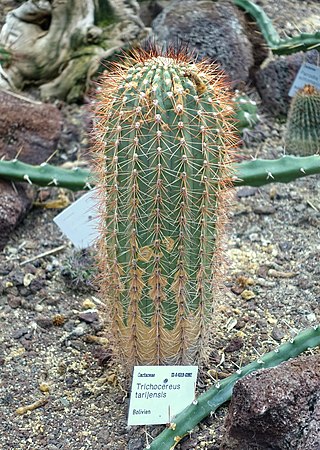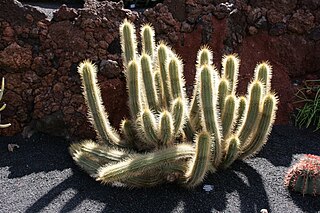
Stetsonia coryne, the toothpick cactus, is the sole species in the cactus genus Stetsonia. Stetsonia coryne grows to a height of 15 to 25 ft tall. It has white flowers.

Soehrensia schickendantzii is a cactus found in northwestern Argentina in provinces of Salta and Tucumán at elevations of 1600 to 3200 meters.

Soehrensia candicans is a species of cactus from northern and western Argentina. It has large fragrant white flowers that open at night.

Soehrensia angelesiae is a species of cactus.

Soehrensia thelegona is a species of cactus in the Soehrensia genus.

Denmoza is a monotypic genus of cacti. Its only species, Denmoza rhodacantha, is native to northwest Argentina.

Soehrensia formosa, is a species of Echinopsis found in South America. In north-western Argentina, Bolivia and northern Chile. First published in Cactac.: Handb. Kakteenk. 3: 1678 in 1959.

Echinopsis densispina, is a species of Echinopsis found in Argentina.

Lobivia bridgesii, is a species of Lobivia found in Bolivia.

Echinopsis haematantha, is a species of Echinopsis found in Argentina and Bolivia.

Lobivia obrepanda, is a species of Lobivia found in Bolivia.

Soehrensia huascha, is a species of Soehrensia in the Cactaceae family, found in north western Argentina. First published in Cactaceae Syst. Init. 29: 5 in 2013.

Soehrensia camarguensis, is a species of Soehrensia found in Bolivia.

Lobivia pentlandii, is a species of Lobivia found in Bolivia and Peru.

Setiechinopsis is a monotypic genus of cacti. Its only species, Setiechinopsis mirabilis, is native to Argentina.

Soehrensia tarijensis, is a species of Soehrensia, in the cactus family. It is native to Bolivia and northwestern Argentina.

Acanthocalycium rhodotrichum is a species of Acanthocalycium found in Argentina, Bolivia, Brazil, Paraguay, and Uruguay

Matucana haynii is a species of Matucana found in Peru.

Acanthocalycium leucanthum is a species of flowering plant in the cactus family Cactaceae from Argentina.

Soehrensia thelegonoides is a species of Soehrensia found in Argentina.
























